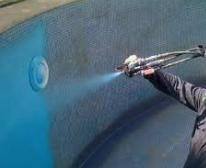Update:There are many principles for the adhesion of water-based polyurethane resins to metal surfaces. Such as mechanical occl...
There are many principles for the adhesion of
water-based polyurethane resins to metal surfaces. Such as mechanical occlusal bonding theory, electrostatic theory, adsorption theory, diffusion theory, acid-base use theory and chemical bond theory. In general, adhesion is the result of a combination of mechanical attachment, electrostatic attraction and chemical bonding. The adhesion strength is a function of the degree of wetting, the relative surface mechanical energy of the two surfaces and the wetting kinetics. In the definition of adhesion, adhesion should refer to the adhesion of the painted metal exposed to high humidity or solution. Commonly known as wet adhesion, it refers to the adhesion exhibited by the coated metal after being placed in a medium environment.

Metal surfaces are covered with grease, dust, rust, and surface smoothness, which are all causes of reduced resin adhesion and poor adhesion. To solve these problems, try the following methods:
1: Polish the surface with sandpaper or steel ball;
2: Clean with organic solvent;
3: Use solvent to corrode the surface, or do phosphating treatment; mainly to increase the concave surface on the surface.
The above is the treatment method made on the metal.
If you want to increase the adhesion, you can also make a fuss in metal coatings, such as adding: polymer polyols, polyisocyanates, crosslinking agents, DMPA, etc.
1: The polyester polyol in the polymer polyol has a good adhesion effect on the adhesion in the polyurethane. However, the configuration with butylene adipate is a key, and the amount of addition directly affects the adhesion.
2: Increasing the hard segment content of polyisocyanate will increase the resin adhesion, and also improve the hardness, water resistance, heat resistance and low temperature resistance of the resin, but the elasticity will be reduced. When the hard segment content is too high, the activity and diffusion capacity of the resin molecular chain will be reduced, resulting in poor infiltration with the substrate, and the resin cannot fully penetrate into the irregularities of the metal surface, so there will be a gap between the resin and the substrate. The presence of voids makes the actual contact area smaller than the corresponding metal surface area and adhesion is reduced.
3: With the increase of the degree of cross-linking, the cohesive strength of the resin as a whole increases, and the adhesion becomes larger, but when the degree of cross-linking further increases, the polymer is difficult to disperse, which affects the microphase separation and damages the cohesion of the resin. Strength, and resin fineness will also increase, reducing adhesion and other properties. The appropriate degree of crosslinking should be controlled between 0.5% and 0.6%.
4: The increase of DMPA will increase the -COOH group in the resin. On the one hand, the -COOH group has high polarity, which is beneficial to increase the adhesion. On the other hand, it increases the water solubility of the resin, making the resin fineness smaller and increasing. The wettability of the resin is improved, which is beneficial to the improvement of adhesion. However, too much -COOH content will reduce the water resistance and seriously affect the wet adhesion of the resin, so the content of DMPA should not be too high and should be controlled at 1.7% to 2.4% of the total resin.

